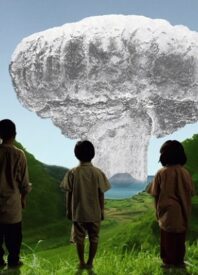
Time, theoretically, is a simple concept, as we in the present take the occasional look to the past. That’s basically what some of the middle aged characters (Yasuko Matsuyuki, Masahiro Takashima, Natsuki Harada) in Casting Blossoms to the Sky are doing, as they interview survivors of the air raids during World War II. In turn, some of these older survivors reach out to younger generations, telling them their stories. The film uses some flashbacks, imagining the experiences of these people. Despite using the documentary elements, most don’t consider this a documentary because it mixes gravitas and whimsy in this mashup. The film reinforces the mashup element as it introduces Hana (Minami Inomata), who we will get into.
OK, so let’s get into Hana now, as Casting Blossoms splices its interview scenes with her, wearing her school uniform, innocently riding her unicycle across Nagaoka. She takes viewers all over the city, recovered after the Great East Japan Earthquake in 2004. That recovery may be physical, but the scars of that earthquake remain in the city’s psyche, and we can say the same about its trauma from decades before, as it received its share of Allied bombing during WWI. Early August is coming, the days before the Hiroshima and Nagasaki anniversary. Hana writes a play recounting the ‘minor’ Nagoaka bombing, and the film shows her affinity with those victims.
The co-writer director behind Casting Blossoms is Nobuhiko Obayashi, who most cinephiles know for Hausu. There are a few good reasons why the guy who director Hausu has the right to tell this story. Someone who grew up during the war can tell this story his own way. Also, everyone who has directed a war film probably has done something silly before hand e.g. the guy who directed some Batman movies. This isn’t me hating on Oppenheimer, although it does highlight the obvious differences and similarities that these two films have. The characters in both films feel something, whether it’s loss or guilt, and Blossoms argues the validity of both. Even with loss, the film is also arguing successfully that the thing that triggers you may be the one that heals.
Viewers will probably also feel Hausu and other cultural influence on this. Without giving a lot away, Hana’s presence adds a magic realist touch to Blossoms, explaining her affinity with generations past. Nagaoka’s August festival begins despite past traumas, recent or otherwise. And the large mascots hint to a thinking that shows that art that isn’t naturalist can still be respectful of those traumas without being a full downer. There’s a palimpsest beautifully working here. Time and visual effects come together, sometimes irreverently, in the same place during the hot summer of 2011. The old dance with the young, and each generation’s history and memory persevere, against all odds.
Watch Casting Blossoms to the Sky on OVID.
- Rated: 15
- Genre: Drama, Fantasy, War
- Directed by: Nobuhiko Obayashi
- Starring: Masahiro Takashima, Minami Inomata, Natsuki Harada, Yasuko Matsuyuki
- Written by: Kôji Hasegawa, Nobuhiko Obayashi
- Studio: PSC

